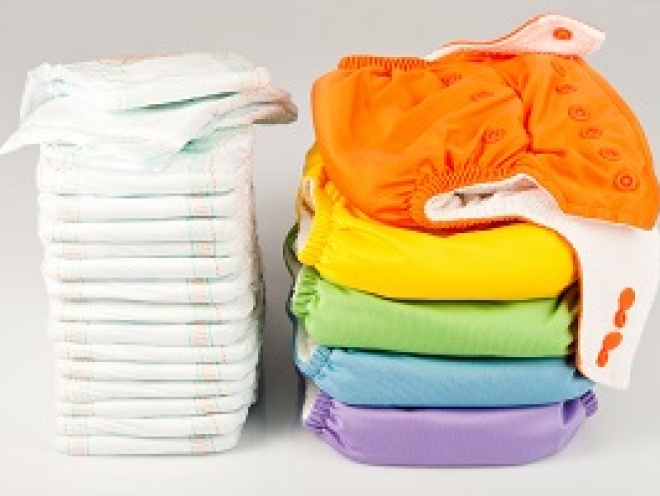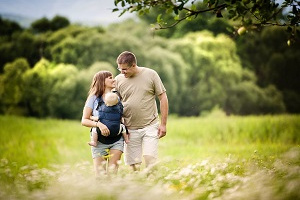Choosing the right nappy for your baby from the daunting number of options can be tricky. So here are the pros and cons of reusable and disposable nappies…
Some parents opt for disposable nappies, while others choose reusable cloth nappies. Others still choose a combination of the two. Many reasons like environmental impact, convenience or costs might affect your choice of nappies.
The environment that we all depend on is an important consideration. Each year, parents throw away around three billion disposable nappies to landfill. That’s about 2% to 3% of all household waste. And that’s a lot considering disposable nappies take up to 500 years to decompose (Which?, 2018a; WRAP, 2018).
On the other hand, reusable nappies might be less convenient than disposable nappies. Disposable nappies can be easier and quicker for time-pressured parents to use. There’s also a lower upfront cost involved for disposables.
Parents might choose a combination of reusable nappies and disposable ones depending on what’s happening. They might use reusable nappies day-to-day at home and swap to disposables for a holiday where there’s no access to a washing machine (The Guardian, 2015).
Here are the pros and cons of reusable and disposable nappies.
Reusable nappies
Positives
- They are better for the environment because you wash and reuse cloth nappies, rather than throwing each one in the bin. Choosing reusable nappies over disposable nappies can halve the average household waste (Which?, 2018a; WRAP 2018).
- Reusable nappies now come in a variety of funky designs, colours and fabrics, with soft cloth inserts and easy fastenings like Velcro or poppers (Which?, 2018a).
- Some reusable nappies come with a removable inner layer that you can slip into your baby's changing bag, and so you don’t have to wash the whole nappy every time (Which?, 2018a).
- Cloth nappies can work out cheaper in the long run. They can be reused for future babies or sold on (Which?, 2018a). Reusable nappies save you around £200 to £500 over the 2.5 years that your baby is likely to be in nappies (WRAP, 2018).
- Some parents say cloth nappies feel softer and more comfortable for their baby’s bottom.
- Natural cloth nappies may be less likely to cause nappy rashes because they don’t use any harsh chemicals, dyes or plastics (Alberta et al, 2005; Pollution Issues, 2013; The Nappy Shed, 2018).
Negatives
- Washing and drying your baby’s reusable nappies takes time, energy, electricity costs and effort (Which?, 2018a).
- Reusable nappies can be less absorbent than disposable nappies, so you might need to change these nappies more often (Which?, 2018a).
- You may have a large upfront cost to get your baby kitted out with a set of reusable nappies (Which?, 2018a). On the other hand, you may find second-hand reusable nappies for sale at your local NCT Nearly New Sale for a fraction of the new price.
- Sometimes it can be tricky to find baby clothes to fit over reusable nappies, depending on their size and design.
- Using cloth nappies can be difficult to manage if you’re going on a holiday as you can’t just throw them away like disposable ones (The Guardian, 2015).
- You need to be extra careful while cleaning them to ensure they are sanitary (Kamat and Malkani, 2003). Recommendations are that cloth nappies should be washed at 60⁰C (Environment Agency, 2008).
Disposable nappies:
Positives
- Some parents prefer the convenience of disposable nappies as they don’t need to be washed and dried. They are good for when you don’t have access to a washing machine – for example on holiday (Which?, 2018b).
- There are plenty of brands and sizes of disposable nappies to choose from to suit your budget (Which?, 2018b).
- They are easily available in any supermarkets or departmental stores and are easy to transport as they are slim and light (Which?, 2018b).
- Initially, disposable nappies can be cost effective.
- Disposable nappies are thought to be more absorbing than cloth nappies (Kamat and Malkani, 2003).
- They are considered to be more sanitary than cloth nappies because of their one-off use (Kamat and Malkani, 2003).
Negatives
- Disposable nappies usually end up in landfill where they take a long time to decompose (Which? 2018a).
- The choice of disposable nappies can be overwhelming. Some parents find certain brands leak or do not fit their baby well, so you might need to shop around.
- The cost of disposable nappies adds up over time (WRAP, 2018).
- Disposable nappies might contain harsh chemicals and an absorbent ingredient (sodium polyacrylate) that can cause nappy rashes (Which?, 2018b).
- It is thought that toddlers using disposable nappies are harder to potty train as they can’t feel the wetness (Which?, 2018b).
- Most people don’t correctly dispose of nappies, i.e. they leave the poo inside the nappy and throw them. While decomposing, the poo inside the nappy lets off methane gas that could contribute to greenhouse gases contributing to global warming (Environment Agency, 2008; Pollution Issues, 2013).
Whichever type of nappy you choose, one thing is certain: you will be changing a lot of nappies. And your little one will spend a lot of time in nappies. So whichever type you choose, make sure they suit you and your baby.
This page was last reviewed in October 2018.
Further information
Our support line offers practical and emotional support with feeding your baby and general enquiries for parents, members and volunteers: 0300 330 0700.
We also offer antenatal courses which are a great way to find out more about birth, labour and life with a new baby.
Make friends with other parents-to-be and new parents in your local area for support and friendship by seeing what NCT activities are happening nearby.
Some local NCT branches run their own cloth nappy library where you can try a range of cloth nappies out to see what suits your baby best. Find out more from your local NCT branch.
There is a second hand reusable nappy market. You may be able to pick up some second hand reusable nappies at your local NCT sale, for a fraction of the price of new ones.
Alberta L, Sweeney SM, Wiss K. (2005) Diaper dye dermatitis. Pediatrics. 116(3):e450-452. Available at: https://www.ncbi.nlm.nih.gov/pubmed/16140691 [Accessed 16th October 2018]
Environment Agency. (2008) An updated lifecycle assessment study for disposable and reusable nappies. Available at: http://randd.defra.gov.uk/Document.aspx?Document=WR0705_7589_FRP.pdf [Accessed 16th October 2018]
Kamat M, Malkani R. (2003) Disposable diapers : a hygienic alternative. Indian Journal of Pediatrics. Available at: https://www.ncbi.nlm.nih.gov/pubmed/14703226 [Accessed 16th October 2018]
Pollution Issues. (2013) Landfill and nappies. Available at: http://www.pollutionissues.co.uk/landfill-nappies.html [Accessed 16th October 2018]
The Guardian. (2015) Nappies: which are best – disposables or reusables. Available at: https://www.theguardian.com/money/2015/jul/04/nappies-which-best-disposables-reusables-cost-ethics [Accessed 16th October 2018]
Which? (2018a) How to buy the best reusable nappies. Available at: https://www.which.co.uk/reviews/nappies/article/how-to-buy-the-best-reusable-nappies [Accessed 16th October 2018]
Which? (2018b) How to buy the best disposable nappies. Available at: https://www.which.co.uk/reviews/nappies/article/how-to-buy-the-best-disposable-nappies [Accessed 16th October 2018]
WRAP. (2018) Real nappies. Overview. Available at: http://www.wrap.org.uk/content/real-nappies-overview [Accessed 16th October 2018]







